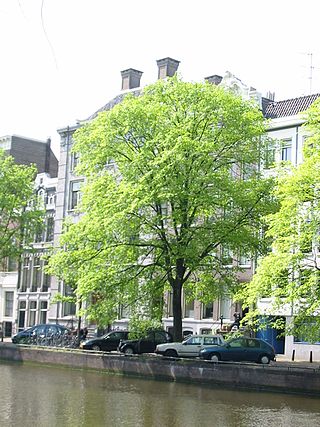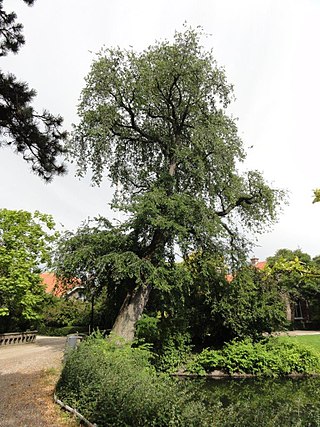
The hybrid elm cultivar Ulmus × hollandica 'Belgica', one of a number of hybrids arising from the crossing of Wych Elm with a variety of Field Elm, was reputedly raised in the nurseries of the Abbey of the Dunes, Veurne, in 1694. Popular throughout Belgium and the Netherlands in the 19th century both as an ornamental and as a shelter-belt tree, it was the 'Hollandse iep' in these countries, as distinct from the tree known as 'Dutch Elm' in Great Britain and Ireland since the 17th century: Ulmus × hollandica 'Major'. In Francophone Belgium it was known as orme gras de Malines.

The hybrid elm cultivar Ulmus × hollandica 'Smithii', commonly known as the Downton Elm, was one of a number of cultivars arising from the crossing of the Wych Elm U. glabra with the Field Elm U. minor. The tree was originally planted at Downton Castle near Ludlow, as one of a batch, not all of them pendulous in habit, raised at Smith's Nursery, Worcester, England, from seeds obtained from a tree in Nottingham in 1810.
The hybrid elm cultivar Ulmus × hollandica 'Dauvessei', one of a number of cultivars arising from the crossing of the Wych Elm U. glabra with a variety of Field Elm U. minor, is a very rare cultivar said to have originated at the D. Dauvesse nursery in Orléans, France before 1877.
The elm cultivar Ulmus 'Atropurpurea' [:dark purple] was raised from seed at the Späth nursery in Berlin, Germany, circa 1881, as Ulmus montana atropurpurea, and was marketed there till the 1930s, being later classed as a cultivar by Boom. Henry (1913) included it under Ulmus montana cultivars but noted that it was "very similar to and perhaps identical with" Ulmus purpureaHort. At Kew it was renamed U. glabraHuds. 'Atropurpurea', but Späth used U. montana both for wych elm and for some U. × hollandica hybrids, so his name does not necessarily imply a wych elm cultivar. The Hesse Nursery of Weener, Germany, however, which marketed 'Atropurpurea' in the 1950s, listed it in later years as a form of U. glabraHuds..

The elm cultivar Ulmus 'Purpurea', the purple-leaved elm, was listed and described as Ulmus Stricta Purpurea, the 'Upright Purpled-leaved Elm', by John Frederick Wood, F.H.S., in The Midland Florist and Suburban Horticulturist (1851), as Ulmus purpureaHort. by Wesmael (1863), and as Ulmus campestris var. purpurea, syn. Ulmus purpureaHort. by Petzold and Kirchner in Arboretum Muscaviense (1864). Koch's description followed (1872), the various descriptions appearing to tally. Henry (1913) noted that the Ulmus campestris var. purpureaPetz. & Kirchn. grown at Kew as U. montana var. purpurea was "probably of hybrid origin", Ulmus montana being used at the time both for wych elm cultivars and for some of the U. × hollandica group. His description of Kew's U. montana var. purpurea matches that of the commonly-planted 'Purpurea' of the 20th century. His discussion of it (1913) under U. campestris, however, his name for English Elm, may be the reason why 'Purpurea' is sometimes erroneously called U. procera 'Purpurea' (as in USA and Sweden.

The Wych Elm cultivar Ulmus glabra 'Cornuta', in cultivation before 1845 – Fontaine (1968) gives its provenance as France, 1835 – is a little-known tree, finally identified as a cultivar of U. glabra by Boom in Nederlandse Dendrologie 1: 157, 1959.
The elm cultivar Ulmus 'Monstrosa' [: "monstrous", "strange"], a shrub-elm with fasciated branching, is believed to have originated in France, where it was first listed by Lavallée in Arboretum Segrezianum (1877) as a form of Field Elm, Ulmus campestris var. monstrosa, but without description. Though its long slender 2 cm petiole is not a feature of wych elm U. glabraHuds., and is even less likely in a shrub form of this species, the wych-cultivar error arose early, perhaps because the Späth nursery of Berlin, using Ulmus montana both for some Ulmus × hollandica cultivars and for wych varieties, listed it c.1890 as Ulmus montana monstrosa. Hartwig in Illustrirtes Gehölzbuch (1892) followed with Ulmus scabra monstrosa, an error repeated by Krüssman (1962) and by Green (1964), with their U. glabraHuds. 'Monstrosa'.
The Wych Elm cultivar Ulmus glabra 'Corylifolia Purpurea' was raised from seed of 'Purpurea' and described as U. campestris corylifolia purpurea by Pynaert in 1879. An U. campestris corylifolia purpurea was distributed by the Späth nursery of Berlin in the late 19th and early 20th centuries. The Hesse Nursery of Weener, Germany, corrected the U. campestris corylifolia purpurea of their 1930s' lists to U. glabraHuds.corylifolia purpurea by the 1950s. Green listed 'Corylifolia Purpurea' as a form of U. glabra.
The elm cultivar Ulmus 'Escaillard' was first described by Dumont de Courset in 1811, and listed, without description, as Ulmus escaillard, by the André Leroy nursery at Angers, France, in 1849. It was distributed by the Baudriller nursery of Angers and by Hesse's nursery, Weener, Germany, as U. campestris 'Escaillardii', both nurseries using U. montana for wych elm cultivars. Herbarium specimens from a tree in The Hague obtained from the Hesse nursery label it variously U. glabra 'Escaillardii' and Ulmus × hollandica 'Escaillardi'. The latter was Christine Buisman's determination (1931), identifiable as hers by its handwriting and red label.
The Wych elm cultivar Ulmus glabra 'Latifolia Aureo-Variegata' was first mentioned by Neubert in Deutsches Magazin für Garten- und Blumenkunde 1871 as Ulmus campestrisL.latifolia aureo-variegata.
The elm cultivar Ulmus 'Rugosa' [:'wrinkled', the leaves], was first listed in Audibert's Tonelle (1817), as "U. campestris Linn. 'Rugosa' = orme d'Avignon [Avignon elm] ", but without description. A description followed in the Revue horticole, 1829. Green (1964) identified this cultivar with one listed by Hartwig and Rümpler in Illustrirtes Gehölzbuch (1875) as Ulmus montana var. rugosaHort.. A cultivar of the same name appeared in Loddiges' catalogue of 1836 and was identified by Loudon in Arboretum et Fruticetum Britannicum (1838) as Ulmus montana var. rugosaMasters, Masters naming the tree maple-bark elm. Ulmus montana was used at the time both for wych cultivars and for some cultivars of the Ulmus × hollandica group.
The Elm cultivar Ulmus 'Tiliaefolia' was first mentioned by Host in Flora Austriaca (1827), as Ulmus tiliaefolia [:linden-leaved]. The Späth nursery of Berlin distributed a 'Tiliaefolia' from the late 19th century to the 1930s as neither an U. montana hybrid nor a field elm cultivar, but simply as Ulmus tiliaefolia, suggesting uncertainty about its status. Herbarium specimens appear to show two clones, one smaller-leaved and classified as a field elm cultivar, the other larger-leaved.
The elm cultivar Ulmus 'Tortuosa'Host, the Wiggly Elm, was described by Host in Flora Austriaca (1827) as Ulmus tortuosa, from low, twisted, small-leaved trees that grew in the hilly districts of Hungary. A contemporary herbarium specimen (1833) from Central Europe labelled U. tortuosaHost appears to show small field elm-type leaves. Henry distinguished 'Tortuosa' Host from Loddiges' and Loudon's U. tortuosa, which he identified with Ulmus 'Modiolina', "l'orme tortillard" of France. Henry noted, however, that abnormal sinuous or zigzagging growth "might occur in any kind of elm", and herbarium specimens of elms labelled 'Tortuosa' range from U. minor cultivars to hybrid cultivars, some treated as synonymous with 'Modiolina'. A large-leaved U. campestris tortuosa was described by David in Revue horticole (1846), while a hybrid var. tortuosa cultivar from Louveigné, Belgium, with twisted trunk and large leaves, was described by Aigret in 1905. An U. campestris suberosa tortuosa was marketed in the 1930s by the Hesse Nursery of Weener, Germany, by its description a contorted form of corky-barked field elm.
Ulmus × hollandica 'Pitteurs' or 'Pitteursii', one of a number of hybrid cultivars arising from the crossing of the Wych Elm Ulmus glabra with a variety of Field Elm Ulmus minor, was first identified by Morren as l'orme Pitteurs (1848). Elwes and Henry (1913) and Krüssmann (1976) listed it as an Ulmus × hollandica cultivar. It was named after the landowner Henri Bonaventure Trudon de Pitteurs of Saint-Trond, near Liège, Belgium, who discovered and first propagated the tree on his estate.

The hybrid elm cultivar Ulmus × hollandica 'Gaujardii', one of a number of cultivars arising from the crossing of Wych Elm U. glabra with Field Elm U. minor, was raised by the Gaujard-Rome nursery of Châteauroux, France, in the 1890s as Ulmus Gaujardii and was described in the 1898 Kew Bulletin and Wiener illustrirte Garten-Zeitung. It won first prize in the International Horticultural Exhibition in Saint Petersburg, Russia, in 1899 and a silver medal in the Heemstede Exhibition, The Netherlands, in 1925. From the early 20th century it was distributed by the Späth nursery of Berlin as Ulmus montana Gaujardi, and in the interwar years by the Boccard nursery of Geneva as Ulmus campestris Gaujardi. It appeared in Unsere Freiland-Laubgehölze in 1913, but without description.

The putative Wych Elm cultivar Ulmus glabra 'Latifolia' was identified in Audibert's Tonelle (1817) as U. campestrisLinn. [ = U. glabraHuds.] latifolia. The tree is reputed to have originated circa 1750 in or around Mechelen, and to have been widely planted throughout Belgium. A 1912 herbarium specimen from Oudenbosch, however, shows a hybrid leaf labelled Ulmus hollandica latifolia.

The Field Elm cultivar Ulmus minor 'Pendula' was said to have been raised in Belgium in 1863. It was listed as Ulmus sativa pendula by C. de Vos in 1887, and by Boom in 1959 as a cultivar.
The hybrid elm cultivar Ulmus × hollandica 'Elegantissima' was the name given by A. R. Horwood in his Flora of Leicestershire and Rutland (1933) to an elm found in those counties and later identified by Melville as a natural hybrid between Wych Elm and Plot Elm. According to Melville, the hybrid occurs in the main areas of Plot Elm distribution, where it is more common than Plot Elm itself. The tree is sometimes known simply as the 'Midlands Elm'.
The Wych Elm cultivar Ulmus glabra 'Grandidentata', listed as U. glabra var. grandidentata (Moss), may have been the tree first described by Dumortier in Florula Belgica, 25, 1827, as U. corylacea var. grandidentata, in cultivation before 1830. Green thought it a synonym of 'Cornuta'. 'Grandidentata' may be synonymous with U. glabra 'Corylifolia', which Green thought another synonym of 'Cornuta'.

The wych elm cultivar Ulmus glabraHuds. 'Superba', Blandford Elm, with unusually large leaves, was raised by Gill's of Blandford Forum, Dorset, in the early 1840s as Ulmus montana superba and was quickly distributed to other UK nurseries. It was confirmed as a form of wych, and first described by Lindley in The Gardeners' Chronicle, 1845, later descriptions being added by Gill (1845) and Morren (1848), who called it U. montana var. superba. Morren had adopted the name 'Superba' from the Fulham nurseryman Osborne in 1844, who supplied him with the tree – presumably one of the nurseries supplied by Gill. Morren states that 'Superba', already in cultivation in England, was introduced to Belgium by Denis Henrard of Saint Walburge, Liège, that in 1848 it had been present in Belgium for only three years, and that this variety was the one described as 'Superba' by Osborne, whom Henrard had visited at his nursery in Fulham in September 1844. 'Blandford Elm', with leaves of the same dimensions, was soon for sale in the USA.











